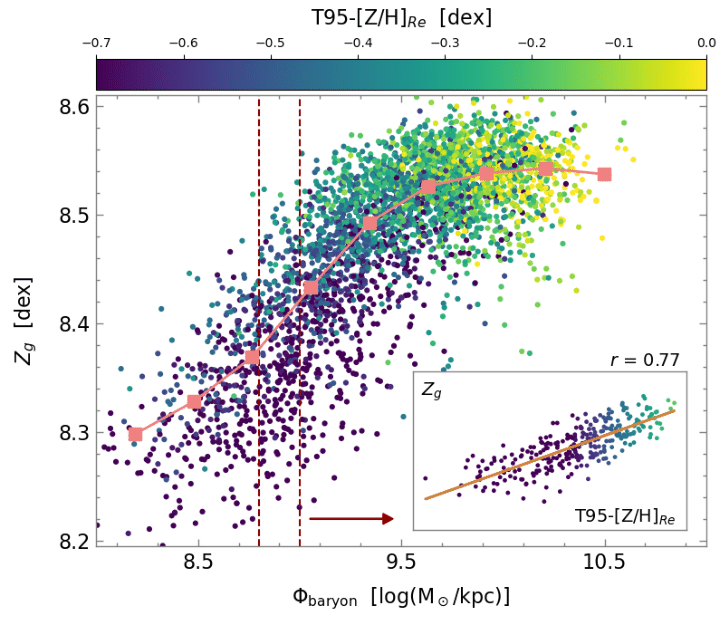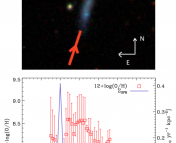Title: More fundamental than the fundamental metallicity relation: The effect of the stellar metallicity on the gas-phase mass-metallicity and gravitational potential-metallicity relations.
Authors: Sánchez-Menguiano, L., Sánchez S. F., Sánchez Almeida, & J., Muñoz-Tuñón, C.
First Author’s Institution: Dpto. de Física Teórica y del Cosmos, Facultad de Ciencias (Edificio Mecenas), Universidad de Granada, E-18071 Granada, Spain.
Status: Accepted to Astronomy & Astrophysics Letters [open access]
Here on Earth, we interact with a plethora of different elements on a daily basis, but in the very early universe, the only two elements present were hydrogen and helium. These two elements formed the first stars and galaxies, and as stars evolved, heavier and heavier elements were created. Exactly how the universe evolved from a primordial cloud of hydrogen and helium to the environments we live in today remains an open question for astronomers. If we can understand how a galaxy’s metallicity (astronomers consider anything heavier than helium to be a metal) varies according to other properties like mass, star formation rate, or stellar population, we can begin to build a picture of the universe’s chemical evolution.
Astronomers have already found a relationship between the metallicity of a galaxy’s gas and the mass of all the stars in that galaxy. In our local neighborhood, it seems that more massive galaxies are more metal-rich, and this positive correlation flattens out at higher masses. However, there’s a lot of scatter in the data which may be driven by different galactic properties. The metallicity of a galaxy can be affected by a whole host of processes: metal-rich gas can be carried away from the galaxy by outflows, metal-poor gas can fall into a galaxy, and supernovae can enrich the interstellar medium with heavy elements. The question is how big a role each process plays in the long-term chemical evolution of galaxies.
The authors of today’s paper look into the relationship between stellar mass, gravitational potential, and metallicity. The authors find that the correlation between potential and metallicity (the ΦZR) is tighter than the correlation between mass and metallicity (the MZR), and when stellar metallicity is folded in as a third parameter, the scatter can be significantly reduced. The galaxies in the authors’ used a sample of 3,430 galaxies observed by the MaNGA campaign, as part of the Sloan Digital Sky Survey.

While gravitational potential and mass might seem like they’re two sides of the same coin, gravitational potential actually tells us about both the galaxy’s mass and its physical size. A more compact galaxy will have a higher gravitational potential than an equally massive but physically larger galaxy. This can help explain why the ΦZR has a different scatter to the MZR, as a potential is more important in determining how gas flows in and out of the galaxy than pure mass. The authors conduct the same analysis on both the ΦZR and MZR, but for the purposes of this article, we’ll be focusing on the ΦZR.
When the authors plot gas metallicity against the potential of the galaxy (as in Figures 1 and 2), we can see the expected positive correlation between the two, which flattens out towards higher masses. But there’s still a lot of scatter around the best-fit line, plotted in salmon. To identify the potential third parameter driving this scatter, the authors subtract the known dependence on potential, and then use a method known as a random forest regressor (RF regressor). The RF regressor takes a random sample of the data points, and uses a series of decision trees to identify the most important parameters that can be used to predict the gas metallicity of a data point. The process is repeated many times until a robust estimate of the importance of each additional parameter is achieved.

After running the RF regressor, the authors find that the most important additional parameter is stellar metallicity, specifically the stellar metallicity at the time that the galaxy formed 95% of its mass. Incorporating this third parameter into the relationship between gas metallicity and potential can reduce scatter by 14%, far more than any other parameter considered!
In the past, star-formation rate (SFR) has been suggested as the crucial third parameter in explaining the scatter in the ΦZR. However, the authors find that SFR is less important than stellar metallicity, and cannot reduce scatter as much. You can see this in the inset panels in Figures 1 and 2, which show the correlation between gas metallicity and either stellar metallicity (Figure 1) or SFR (Figure 2). The panel in Figure 1 shows a much tighter correlation than the panel in Figure 2, demonstrating that stellar metallicity has a more direct impact on the MZR than SFR does.
Today’s paper suggests that star formation is not one of the key drivers of a galaxy’s metallicity, as had been suggested in the past. Instead, it shows that stellar metallicity is closely related to the long-term chemical enrichment history of a galaxy, while SFR impacts much shorter timescales. As a result, the dependence on stellar metallicity over SFR suggests that gas metallicity is driven by long-term effects, rather than being sensitive to recent events, such as a bout of star formation. This paper brings us one step closer to pinning down exactly what effects are driving chemical evolution and creating galaxies like our own.
Astrobite edited by Amaya Sinha
Featured image credit: NASA/JPL-Caltech/ESA/Harvard-Smithsonian CfA





If I understand it well, the star metallicity depends on gas metallicity the star is made of. So the result means that the gas metallicity mostly depends on itself?
Yes and no! You’re right that a star’s metallicity depends on the metallicity of the gas that formed it, but crucially, gas metallicity can continuously evolve with time, while a star’s metallicity is kind of like a “snapshot” of the gas metallicity at a given time. If short-term effects like starbursts or supernova feedback where the main factors changing gas metallicity, we’d expect the gas metallicity to change a lot between the time that most of the stars formed and the time we observe the galaxy. The fact that gas metallicity is correlated with stellar metallicity (and specifically the stellar metallicity at the time that 95% of the galaxy’s stars were formed, i.e., some time in the past) suggest that shorter-term effects might not have a huge impact on gas metallicity.